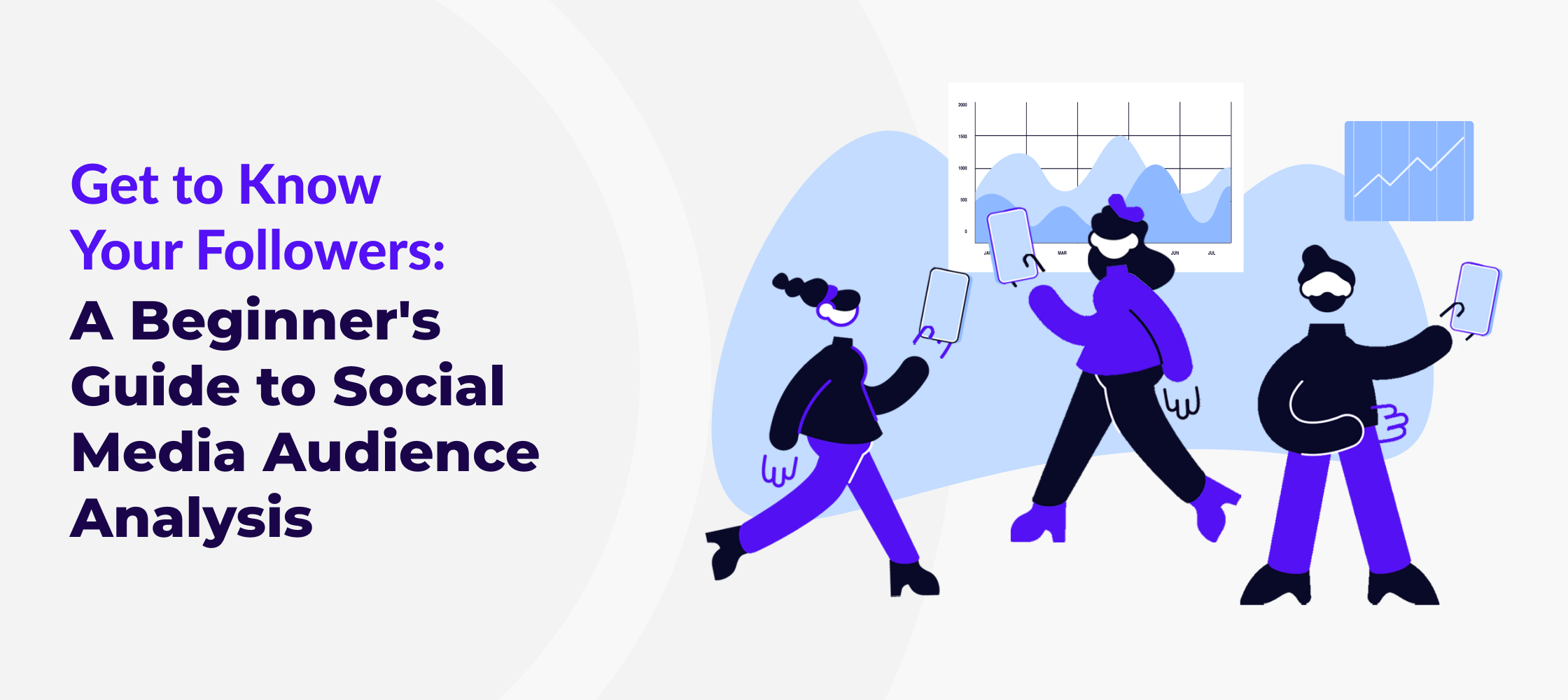 Successful brands on social media have one thing in common: they get to know their target audience. In an age where consumers are all online, face-to-face interviews and focus groups have been replaced with social listening tools and analytics. Savvy, in-the-know brands are using this data to create the ultimate audience-informed strategies. Here is our beginner’s guide to social media audience analysis to help you understand, and reach your target audience.
Successful brands on social media have one thing in common: they get to know their target audience. In an age where consumers are all online, face-to-face interviews and focus groups have been replaced with social listening tools and analytics. Savvy, in-the-know brands are using this data to create the ultimate audience-informed strategies. Here is our beginner’s guide to social media audience analysis to help you understand, and reach your target audience.
What is Social Media Audience Analysis?
A social media audience analysis helps brands learn more about their target audience. Analyzing key demographic information like audience behaviors, interests, and preferences enables brands to gain a deeper understanding of their target audience. This helps businesses make informed decisions around strategy and create targeted content and campaigns for increased engagement.
Why You Should Perform a Social Media Audience Analysis
Audience analysis can help your business understand more about your target audience, which can be baked right into your strategy and campaigns. The analysis also enables your brand to make sure your marketing efforts and resources are aligned with your audience’s needs and your brand objectives.
Benefits of audience analysis
When your organization takes the time to understand its audience through audience analysis, it can reap numerous benefits that will help tailor its message and marketing strategies. The benefits of an effective audience analysis include:
- Understanding your audience’s needs and preferences
- Creating effective and targeted social media content
- Identifying new opportunities for growth and innovation
- Improve your social media ROI
- Enhancing your overall brand reputation and credibility
Key Components in an Audience Analysis
Eight key components must be considered to conduct an effective social media audience analysis. These components include information ranging from demographics and psychographics to habits and influencers.
- Demographic information: age, gender, location, education, and income
- Psychographic information: personality traits, values, interests, and lifestyles
- Social media behavior: platform usage, posting habits, and engagement patterns
- Content preferences: topics, formats, tone, and style
- Pain points and challenges: what problems your audience is facing
- Buying habits and decision-making factors
- Feedback and reviews: what your audience is saying about your brand and competitors
- Influencers and brand advocates: who your audience is following and engaging with
How to Perform a Social Media Audience Analysis
A social media audience analysis is an essential tool to develop an effective social strategy and reach your overall social media goals. Follow the next few steps to learn how to perform an audience analysis that will resonate with your target audience.
1. Define your target audience
A target audience is a group of individuals defined by specific behaviors, interests, and demographics. Your target audience usually gathers people who resonate the most with your brand values and products: they are your ideal customers. To ensure your marketing efforts flourish and work with your target audience, learning about their needs, preferences, and behaviors is essential.
2. Select social media platforms that matter
Your organizations should take the time to choose the social media platforms that matter to your target audience. Depending on your brand goals and audience demographics, you may consider platforms like X, Instagram, LinkedIn, Facebook, or Reddit, to name a few. Your business must understand where its audience spends their time online and what type of content they engage with to select the best platforms to focus efforts on.
3. Choose your social media analytics tool
Social media analytics tools can help your brand conduct its social media audience analysis while streamlining the whole process. Some of the popular platforms for social analytics include Sprinklr, Social Rank, Facebook Audience Insights, Page Insights, Instagram Insights, Twitter Analytics, LinkedIn Analytics, and Pinterest Analytics. These tools will enable your organization to use social listening to gather data on your target audience, such as their interests, behavior, and engagement patterns.
4. Select your metrics
Metrics are a key part of successfully analyzing content on social media and spotting specific patterns in audiences. Some of the essential metrics to consider include reach, engagement, sentiment, impressions, click-through rate, and conversation rates. Your organization’s chosen metrics will depend on your specific goals and audience. The right metric for your brand will help you understand your audience better and improve the overall effectiveness of your social media strategy.
5. Collect and analyze data
Once your brand has determined the metrics you wish to track, you can start gathering data from various sources and tools, such as social media analytics tools, website analytics, customer feedback, surveys, and social media audits. From this point, your brand can analyze the data to identify patterns, trends, and insights. This analysis will help you gain a better understanding of your audience, so you can create more targeted and effective content and campaigns.
Applying the Gathered Data to your Social Media Strategy
As a brand, gathering data into your strategy helps you have a clear understanding of your audience, so you can turn those insights into custom-tailored strategies for each platform. The following are tips to best apply the data to your strategy.
Identify trends
Trends are an important element when seeking to create a successful social media strategy, as they foster engagement in your audience. Your brand can identify popular trends among your target audience using social listening tools. Once you identify a set of trends, look for ways to integrate them into your strategy in an organic way that will appeal to your audience, attract more followers, and improve your overall social media presence.
Identify key insights from your audience
Social media offers valuable insights that can help your business gain a deeper understanding of your audience’s needs, motivations, and characteristics. Every time a user engages with your brand they are giving you key information about their behaviors, their preferences, and their opinions.
- Your audience’s behaviors can inform you about their social media use, such as platform usage, posting habits, and engagement patterns. This information translates into understanding the perfect posting time for your brand to reach maximum engagement.
- Their preferences give you data on their content interests like the topics, formats, and tone that would catch your audience’s interest. Engagement metrics, such as likes, comments, and shares can give you further insights into your audience preferences.
- The opinions your audience shares on social media offer great insight into what they think about your brand and your competitors, as well as issues they are facing that your business could resolve through your services and product offerings.
Your brand can access this key information using your chosen social media analytics tool. These insights will help your brand create content, products, services, and strategies that resonate with your audience and keep them engaged.
Develop a content strategy
With valuable insights from your audience and popular trends in mind, your business is ready to create a content strategy. This strategy should include a plan with the type of content you will post, the frequency of your posts, and the platforms you will use. A well-planned social media strategy will help you stay organized and consistent in your social media efforts, as well as ensure that your content performs to its best potential and caters to your target audience’s interests.
Tailor your approach to each platform
Social media platforms each have different requirements and appeal to different customers. This means that your brand should choose platforms that your target audience spends the most time on, as well as create content specific to that platform and its audience. For example, Instagram content should focus more on eye-catching visuals, while TikTok is all about short and efficient videos. Your brand should adopt a tailored approach for each platform to help maximize engagement and reach across all platforms.
Leverage influencers
Influencers can help you reach a wider audience and increase engagement on your social media platforms. You can identify influencers in your niche industry that connect with your audience, and collaborate with them to create content that promotes your brand in an engaging way. Collaborations will help your brand reach new audiences and build your brand’s credibility.
Discover Insights From Your Audience with ICUC
Audience insights and analytics tools can ultimately help your brand create more targeted and effective marketing campaigns. ICUC’s audience insights solutions help measure, analyze, and track audience activity to gain a deeper understanding of their needs and help anticipate trends in their behaviors. Learn more about how your brand can get to know your audience better by scheduling a meeting with us today.
